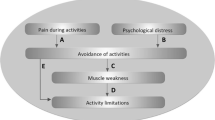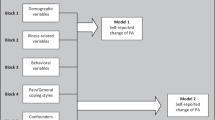Abstract
Background
Pain-related avoidance of activities is hypothesized to lead to lower muscle strength and thereby activity limitations. Negative affect (e.g., low vitality, depression) is thought to strengthen the tendency to avoid activities.
Purpose
The aim of this study was to assess the validity of this “avoidance model” in patients with early symptomatic knee osteoarthritis (OA).
Methods
Cross-sectional data (n = 151) were used. The associations between pain, negative affect, avoidance, muscle strength, and activity limitations were modeled using structural equation modeling.
Results
Pain and negative affect were associated with lower muscle strength via avoidance (mediation by avoidance). Avoidance was associated with activity limitations via lower muscle strength (mediation by muscle strength). There were also direct associations between pain, negative affect, avoidance, muscle strength, and activity limitations.
Conclusions
The results support the validity of the avoidance model, which explains the associations between pain, negative affect, avoidance, muscle strength, and activity limitations in patients with early symptomatic knee OA.



Similar content being viewed by others
References
Brooks PM. Impact of osteoarthritis on individuals and society: How much disability? Social consequences and health economic implications. Curr Opin Rheumatol 2002; 14(5):573-577.
Dekker J, van Dijk GM, Veenhof C. Risk factors for functional decline in osteoarthritis of the hip or knee. Curr Opin Rheumatol 2009; 21(5):520-524.
Hopman-Rock M, Kraaimaat FW, Odding E, Bijlsma JW. Coping with pain in the hip or knee in relation to physical disability in community-living elderly people. Arthritis Care Res 1998; 11(4):243-252.
Steultjens MP, Dekker J, Bijlsma JW. Coping, pain, and disability in osteoarthritis: A longitudinal study. J Rheumatol 2001; 28(5):1068-1072.
van Baar ME, Dekker J, Lemmens JA, Oostendorp RA, Bijlsma JW. Pain and disability in patients with osteoarthritis of hip or knee: The relationship with articular, kinesiological, and psychological characteristics. J Rheumatol 1998; 25(1):125-133.
Linton SJ. New avenues for the prevention of chronic musculoskeletal pain and disability. Amsterdam: Elsevier Health Sciences, 2002.
Turk DC, Flor H. Etiological theories and treatments for chronic back pain. II. Psychological models and interventions. Pain 1984; 19(3):209-233.
Philips HC. Avoidance behaviour and its role in sustaining chronic pain. Behav Res Ther 1987; 25(4):273-279.
Keefe FJ, Gil KM. Behavioral concepts in the analysis of chronic pain syndromes. J Consult Clin Psychol 1986; 54(6):776-783.
Dolce JJ, Raczynski JM. Neuromuscular activity and electromyography in painful backs: Psychological and biomechanical models in assessment and treatment. Psychol Bull 1985; 97(3):502-520.
Dekker J, Tola P, Aufdemkampe G, Winckers M. Negative affect, pain and disability in osteoarthritis patients: The mediating role of muscle weakness. Behav Res Ther 1993; 31(2):203-206.
Steultjens MP, Dekker J, Bijlsma JW. Avoidance of activity and disability in patients with osteoarthritis of the knee: The mediating role of muscle strength. Arthritis Rheum 2002; 46(7):1784-1788.
Bandura A. Self-efficacy: Toward a unifying theory of behavioral change. Psychol Rev 1977; 84(2):191-215.
Baron RM, Kenny DA. The moderator-mediator variable distinction in social psychological research: Conceptual, strategic, and statistical considerations. J Pers Soc Psychol 1986; 51(6):1173-1182.
Rose BM, Holmbeck GN, Coakley RM, Franks EA. Mediator and moderator effects in developmental and behavioral pediatric research. J Dev Behav Pediatr 2004; 25(1):58-67.
Rosqvist E, Heikkinen E, Lyyra TM, Hirvensalo M, Kallinen M, Leinonen R et al. Factors affecting the increased risk of physical inactivity among older people with depressive symptoms. Scand J Med Sci Sports 2009; 19(3):398-405.
Vlaeyen JW, Linton SJ. Fear-avoidance and its consequences in chronic musculoskeletal pain: A state of the art. Pain 2000; 85(3):317-332.
Wesseling J, Dekker J, van den Berg WB, Bierma-Zeinstra SM, Boers M, Cats HA et al. CHECK: Cohort Hip & Cohort Knee; similarities and differences with the Osteoarthritis Initiative. Ann Rheum Dis 2009; 68:1413-1419.
Bellamy N, Buchanan WW, Goldsmith CH, Campbell J, Stitt LW. Validation study of WOMAC: A health status instrument for measuring clinically important patient relevant outcomes to antirheumatic drug therapy in patients with osteoarthritis of the hip or knee. J Rheumatol 1988; 15(12):1833-1840.
Roorda LD, Jones CA, Waltz M, Lankhorst GJ, Bouter LM, van der Eijken JW et al. Satisfactory cross cultural equivalence of the Dutch WOMAC in patients with hip osteoarthritis waiting for arthroplasty. Ann Rheum Dis 2004; 63(1):36-42.
Veenhof C, Bijlsma JW, van den Ende CH, van Dijk GM, Pisters MF, Dekker J. Psychometric evaluation of osteoarthritis questionnaires: A systematic review of the literature. Arthritis Rheum 2006; 55(3):480-492.
Ware JE, Jr., Sherbourne CD. The MOS 36-item short-form health survey (SF-36). I. Conceptual framework and item selection. Med Care 1992; 30(6):473-483.
Ware JE, Snow KK, Kosinski M, Gandek B. SF-36 Health Survey Manual and Interpretation Guide. Boston, MA: New England Medical Center, The Health Institute; 1993.
Aaronson NK, Muller M, Cohen PD, Essink-Bot ML, Fekkes M, Sanderman R et al. Translation, validation, and norming of the Dutch language version of the SF-36 Health Survey in community and chronic disease populations. J Clin Epidemiol 1998; 51(11):1055-1068.
Kraaimaat FW, Evers AW. Pain-coping strategies in chronic pain patients: Psychometric characteristics of the pain-coping inventory (PCI). Int J Behav Med 2003; 10(4):343-363.
Perrot S, Poiraudeau S, Kabir M, Bertin P, Sichere P, Serrie A et al. Active or passive pain coping strategies in hip and knee osteoarthritis? Results of a national survey of 4,719 patients in a primary care setting. Arthritis Rheum 2008; 59(11):1555-1562.
Tan J, Balci N, Sepici V, Gener FA. Isokinetic and isometric strength in osteoarthrosis of the knee. A comparative study with healthy women. Am J Phys Med Rehabil 1995; 74(5):364-369.
Madsen OR, Bliddal H, Egsmose C, Sylvest J. Isometric and isokinetic quadriceps strength in gonarthrosis; inter-relations between quadriceps strength, walking ability, radiology, subchondral bone density and pain. Clin Rheumatol 1995; 14(3):308-314.
Steultjens MP, Dekker J, van Baar ME, Oostendorp RA, Bijlsma JW. Muscle strength, pain and disability in patients with osteoarthritis. Clin Rehabil 2001; 15(3):331-341.
Kellgren JH, Lawrence JS. Radiological assessment of osteo-arthrosis. Ann Rheum Dis 1957; 16(4):494-502.
Rejeski WJ, Ettinger WH, Jr., Schumaker S, James P, Burns R, Elam JT. Assessing performance-related disability in patients with knee osteoarthritis. Osteoarthritis Cartilage 1995; 3(3):157-167.
Field A. Discovering Statistics Using SPSS. 2nd ed. London: SAGE Publications Ltd, 2005.
Muthén LK, Muthén BO. Mplus User’s Guide. Sixth ed. Los Angeles, CA: Muthén & Muthén, 2010.
Shrout PE, Bolger N. Mediation in experimental and nonexperimental studies: New procedures and recommendations. Psychol Methods 2002; 7(4):422-445.
Mackinnon DP, Warsi G, Dwyer JH. A Simulation Study of Mediated Effect Measures. Multivariate Behav Res 1995; 30(1):41.
Preacher KJ, Hayes AF. Asymptotic and resampling strategies for assessing and comparing indirect effects in multiple mediator models. Behav Res Methods 2008; 40(3):879-891.
Hu L, Bentler PM. Cutoff criteria for fit indexes in covariance structure analysis: Conventional criteria versus new alternatives. Struct Equ Modeling 1999; 6(1):1-55.
Satorra A, Bentler PM. A scaled difference chi-square test statistic for moment structure analysis. Psychometrika 2001; 66(4):507-514.
MPlus website. Chi-square difference test for MLM and MLR. Available at http://www.statmodel.com/chidiff.shtml. Accessibility verified January 25, 2012.
Somers TJ, Keefe FJ, Godiwala N, Hoyler GH. Psychosocial factors and the pain experience of osteoarthritis patients: New findings and new directions. Curr Opin Rheumatol 2009; 21(5):501-506.
Axford J, Heron C, Ross F, Victor CR. Management of knee osteoarthritis in primary care: Pain and depression are the major obstacles. J Psychosom Res 2008; 64(5):461-467.
Knoop J, van der Leeden M, Thorstensson CA, Roorda LD, Lems WF, Knol DL et al. Identification of phenotypes with different clinical outcomes in knee osteoarthritis: Data from the Osteoarthritis Initiative. Arthritis Care Res (Hoboken) 2011; 63(11):1535-1542.
Creamer P, Lethbridge-Cejku M, Hochberg MC. Factors associated with functional impairment in symptomatic knee osteoarthritis. Rheumatology (Oxford) 2000; 39(5):490-496.
van der Esch M, Steultjens M, Harlaar J, Knol D, Lems W, Dekker J. Joint proprioception, muscle strength, and functional ability in patients with osteoarthritis of the knee. Arthritis Rheum 2007; 57(5):787-793.
O’Reilly SC, Jones A, Muir KR, Doherty M. Quadriceps weakness in knee osteoarthritis: The effect on pain and disability. Ann Rheum Dis 1998; 57(10):588-594.
Acknowledgments
CHECK is funded by the Dutch Arthritis Association on the lead of a steering committee comprising 16 members with expertise in different fields of OA chaired by Prof. J.W.J. Bijlsma and coordinated by J. Wesseling, MSc. Involved are Erasmus Medical Center Rotterdam; Kennemer Gasthuis Haarlem; Leiden University Medical Center; Maastricht University Medical Center; Martini Hospital Groningen/Allied Health Care Center for Rheumatology and Rehabilitation Groningen; Medical Spectrum Twente Enschede/Ziekenhuisgroep Twente; Reade, Center for Rehabilitation and Rheumatology (formerly Jan van Breemen Institute)/VU Medical Center Amsterdam; St. Maartenskliniek Nijmegen; University Medical Center Utrecht; and Wilhelmina Hospital Assen.
Conflict of Interest Statement
The authors have no conflict of interest to disclose.
Author information
Authors and Affiliations
Corresponding author
About this article
Cite this article
Holla, J.F.M., van der Leeden, M., Knol, D.L. et al. Avoidance of Activities in Early Symptomatic Knee Osteoarthritis: Results from the CHECK Cohort. ann. behav. med. 44, 33–42 (2012). https://doi.org/10.1007/s12160-012-9353-x
Published:
Issue Date:
DOI: https://doi.org/10.1007/s12160-012-9353-x




